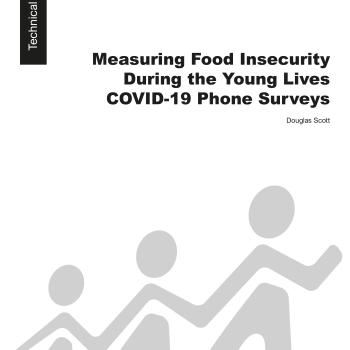
Throughout Young Lives, we have provided various measures of food insecurity. These include the Household Food Insecurity Access Scale (HFIAS), developed by the Food and Nutrition Technical Assistance Project (FANTA) (Coates, Swindale, and Bilinsky 2007), but also stand-alone questions, such as ‘Was there ever no food to eat in your household because of a lack of money?’ which was employed across different survey rounds in all four Young Lives study countries: Ethiopia, India (the states of Andhra Pradesh and Telangana), Peru and Vietnam.
In response to the global COVID-19 pandemic, we conducted the Listening to Young Lives at Work: COVID-19 phone survey to record the experiences of young people during the outbreak. To estimate food insecurity in the four study countries we utilised the Food and Agricultural Organisation’s (FAO) Food Insecurity Experience Scale (FIES) (Cafiero, Viviani, and Nord 2018).
This technical note provides information on how estimates of food insecurity were calculated using the FIES approach, in a manner comparable to the methods used by the FAO to inform the United Nation’s Sustainable Development Goal (SDG) food security indicator.

Throughout Young Lives, we have provided various measures of food insecurity. These include the Household Food Insecurity Access Scale (HFIAS), developed by the Food and Nutrition Technical Assistance Project (FANTA) (Coates, Swindale, and Bilinsky 2007), but also stand-alone questions, such as ‘Was there ever no food to eat in your household because of a lack of money?’ which was employed across different survey rounds in all four Young Lives study countries: Ethiopia, India (the states of Andhra Pradesh and Telangana), Peru and Vietnam.
In response to the global COVID-19 pandemic, we conducted the Listening to Young Lives at Work: COVID-19 phone survey to record the experiences of young people during the outbreak. To estimate food insecurity in the four study countries we utilised the Food and Agricultural Organisation’s (FAO) Food Insecurity Experience Scale (FIES) (Cafiero, Viviani, and Nord 2018).
This technical note provides information on how estimates of food insecurity were calculated using the FIES approach, in a manner comparable to the methods used by the FAO to inform the United Nation’s Sustainable Development Goal (SDG) food security indicator.

